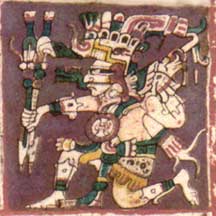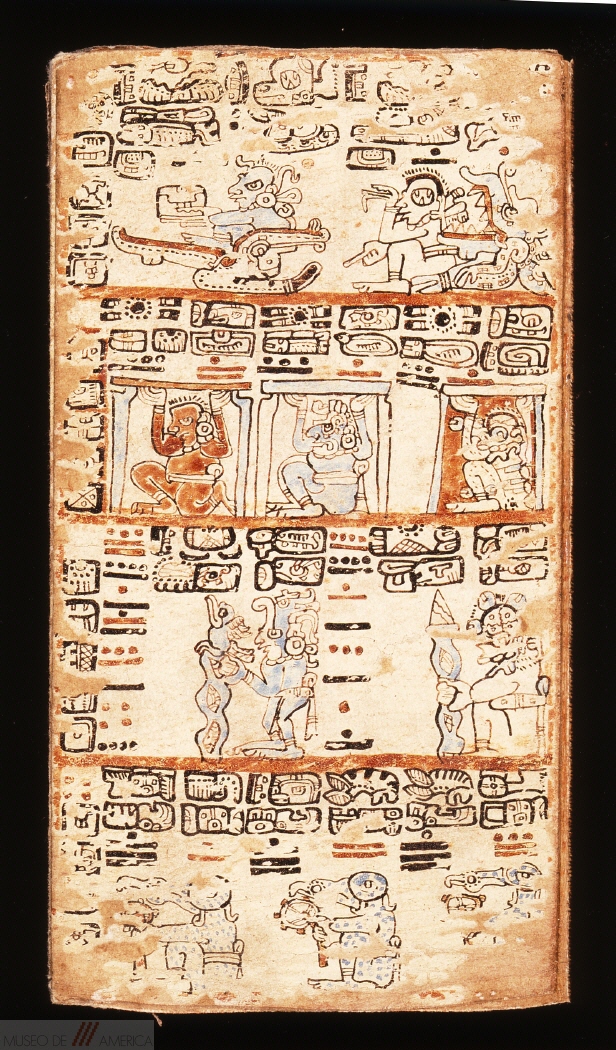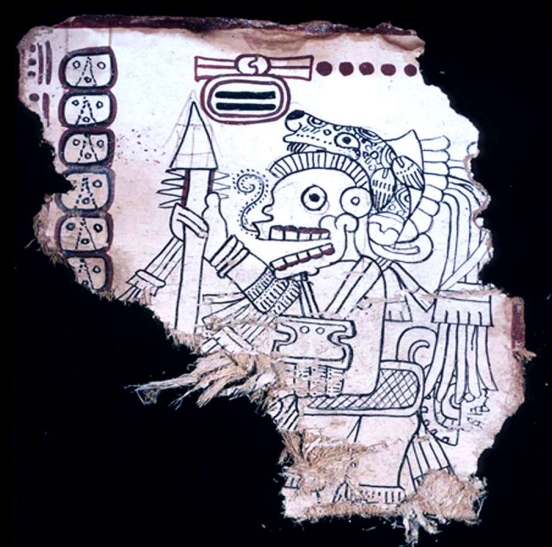Codices
Unfortunately, after Spanish discovery of the area, almost all Maya codices were destroyed. Bishop Diego de Landa was attempting to convert the people of the Yucatán Peninsula, including what was left of the Maya descendants, to Catholicism. When things did not seem to be going the way he’d hoped, he ordered the destruction of the codices in an attempt to void Maya beliefs in their old ways and gods.
In the video below, the Canadian Museum of History has dramatized this scene (video automatically will start at 2 minutes, 15 seconds, but the scene ends at about the 6-minute mark):
Today, only three codices and a possible fourth are known to exist, although it is believed that hundreds, if not thousands, of Mayan codices existed at one time. (Click the link of the codex you’d like to see more about to be taken directly to that section.)
These surviving codices are still being poured over to determine as much as we can discover about the Mayan civilization, beliefs, and writing. Each codex is most popularly named for the city/town or place where it currently resides. “Pre-Columbian Maya books are called codices or screen-folded manuscripts because each book was made of a long strip of paper which was folded like a screen.”
Dresden Codex

Dresden Codex example image
(public domain)
The Dresden Codex is the oldest surviving manuscript. It is currently being held at the Saxon State and University Library Dresden. This codex is also the best preserved and most complete of the four known codices. Scholars believe that this codex was created between 1200-1250 A.D. It contains 39 leaves and is 358 centimeters long (8 inches high by over 11 feet long). Pages were written on both sides.
In 1739, the current Director of the Royal Library at Dresden received this codex from a private owner. The Director eventually gifted the codex to the the library itself. Unfortunately, the codex was damaged during World War II, so often pre-WWII copies of the original are used for study.
Here is an interesting, but quick video of the displayed Dresden Codex:
Information on the University Library’s website states that the Dresden Codex “contains various almanacs, divination calendars, astronomical tables, ritual regulations and numerous representations of gods.” It is thought to have been written by eight separate scribes. The codex is especially important to help scholars decipher the meaning behind the hieroglyphs and the study of Maya belief systems and advancements. Oddly enough, the document was only realized to be a Mayan document in the 1800s.
Over the years, tracings and other renditions (such as slides) have been created from the codex to facilitate study across the world, although not all are considered accurate copies. One may view the original, albeit damaged version on the University Library’s website (or even download a PDF version of it), including the ability to zoom in to view specific sections more closely.
Paris Codex
The Paris Codex is known by many names in the scholarly world: Pérez Codex, Maya-Tzental Codex, Codex Peresianus, and the Codex Mexicanus. (Another lost manuscript was also called the Pérez Codex, so this one often goes by other names to avoid confusion between the two.) It is currently owned by the Bibliothèque nationale de France. As seen in the image above, the page coatings have been wearing away, eroding hieroglyphs and pictures from the pages. This codex includes many colors of paint, including red, turquoise, pink, and blue, and each hieroglyph and image was outlined in black. According to the World Library, the codex contains 11 sheets with 22 pages (front-to-back) of text and images. The strip is 23.5 centimeters high and 140 centimeters long.
“The Paris Codex contains information on calendrical cycles, history, gods and spirits, weather, and astronomy. It is unique of the four surviving codices because it includes historical information and describes Maya constellations.” It also contains information on deities and Mayan zodiac symbols. It is believed that this manuscript dates from about 1185 A.D. to about 1450 A.D. Due to specific notations on the calendar and astronomy that lean to an earlier date, some scholars believe it may be at least a partial copy of an earlier book.
Download the Paris Codex from Bibliothèque nationale de France to study it in more detail.
Madrid Codex

Madrid Codex example page (public domain)
The Madrid Codex is known by several names, including the Tro-Cortesianus Codex. Early in its history among the Europeans, the codex was somehow broken into two parts. Juan Tro y Ortolano was the original owner of the larger portion (the Troano Codex), and it was found in his collection in the late 1800s. (The other fragment is called the Cortesianus Codex, although this section is named after Hernán Cortés, conquistador and leader of the exploratory party that overtook the Aztecs.) The two fragments were discovered to be pieces of one whole by Léon de Rosney, a French scholar, in 1880 when he studied the two pieces, both of which had previously been sold or given to the Museo de América de Madrid.
The Madrid Codex currently resides at the Museo de América in Madrid. Information on the museum’s site, indicates that the codex’s paper was made from pounded ficus bark and stuck together with natural rubber. The single strip was folded into 56 sheets (112 pages front-to-back). It is 22.6 centimeters high and 416.5 centimeters long for one fragment and 238.5 centimeters long for the other fragment. The codex contains religious information for each day on the calendar of sacred rituals. In addition, there is “information on Mayan astrology and divinatory practices, and a number of pages are devoted to the gods of the four cardinal directions and to New Year rites.” Although study has shown that some later paper fragments have been found mixed with older fragments, some believe these were due to repairs on the codex and not due to the codex being written later than suspected, currently believed to be between 1250 A.D. to 1450 A.D. It is also believed that the codex was written by anywhere from one to nine scribes, although most scholars do believe it was written by several.
Download a digital copy of the Madrid Codex to study it more.
Grolier Codex

Grolier Codex example image (public domain)
The Grolier Codex (also called the Sáenz Codex) is an oddity in that it first became known to the world in the 1960s. This leads some to doubt the authenticity of this particular codex. I am going to include it here, as many do include it as one of the four current codices from the Mayan culture. The most commonly used name refers to the Grolier Club in New York, where the manuscript was once displayed. It is currently in the collection of the Museo Nacional de Antropología in Mexico, but is kept in a vault and is not on display.
In the 1970s, Michael Coe published information on the codex with pictures of the codex pages taken by Justin Kerr. According to this document, the document was considered to be from the 1200s. Pages are 18 centimeters high and 12.5 centimeters wide, and in its current condition, the codex contains 11 pages with imagery only on one side of each page.
Check out a complete set of the Grolier Codex page images (originally taken by Justin Kerr).
